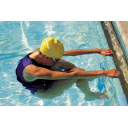|
|
Ways
to improve an angry mood: A look at gender and sports participation
 
  
Research conducted by: Emily
Zitek and Mindy Ater, Rice University
Case study prepared by: Emily
Zitek
Overview
People have different ways of improving their mood when angry.
We have all seen people punch a wall when mad, and indeed, previous
research has indicated that some people aggress to improve their
mood (Bushman, Baumeister & Phillips, 2001). What do the top
athletes do when angry? Striegel (1994) found that anger often hurts
an athlete’s performance and that capability to control anger
is what makes good athletes even better. This study adds to the
past research and examines the difference in ways to improve an
angry mood by gender and sports participation.
The participants were 78 Rice University undergraduates, ages 17
to 23. Of these 78 participants, 48 were females and 30 were males
and 25 were athletes and 53 were non-athletes. People who did not
play a varsity or club sport were considered non-athletes. The 13
contact sport athletes played soccer, football, rugby, or basketball,
and the 12 non-contact sport athletes participated in Ultimate Frisbee,
baseball, tennis, swimming, volleyball, crew, or dance.
The participants were asked to respond to a questionnaire that asked
about what they do to improve their mood when angry or furious.
Then they filled out a demographics questionnaire.
Note: This study used the most recent version
of the State-Trait Anger Expression Inventory (STAXI-2) (Spielberger,
Sydeman, Owen & Marsh, 1999) which was modified to create an
Angry Mood Improvement Inventory similar to that created by Bushman
et al. (2001).
Questions to Answer
Do athletes and non-athletes deal with anger in the same way? Are
there any gender differences? Specifically, are men more likely
to believe that aggressive behavior can improve an angry mood?
Design Issues
This study has
an extremely unbalanced design. There were a lot more non-athletes
than athletes in the sample. In the future, more athletes should be
used. This study originally wanted to look at contact and non-contact
athletes separately, but there were not enough participants to do
this. Future studies could look at this.
Descriptions of Variables
| Variable |
Description |
| Sports |
1 = athletes, 2 = non-athletes |
| Gender |
1 = males, 2 = females |
| Anger-Out (AO) |
high scores demonstrate that people deal with anger by expressing
it in a verbally or physically aggressive fashion |
Anger-In
(AI) |
high scores demonstrate that people experience anger but do
not express it (suppress their anger) |
| Control-Out (CO) |
high scores demonstrate that people control the outward expression
of angry feelings |
| Control-In (CI) |
high scores demonstrate that people control angry feelings
by calming down or cooling off |
| Expression (AE) |
index of general anger expression:
(Anger-Out) + (Anger-In) - (Control-Out) - (Control-In) + 48 |
Note: Description of the items comes from Spielberger
et al. (1999).
| References |
|
Bushman, B.J., Baumeister, R.F. &
Phillips, C.M. (2001). Do people aggress to improve their
mood? Catharsis beliefs, affect regulation opportunity, and
aggressive responding. Journal of Personality and Social Psychology,
81(1), 17-32.
Spielberger, C. D., Sydeman, S. J., Owen,
A. E., Marsh, B. J. (1999). Measuring anxiety and anger with
the State-Trait Anxiety Inventory (STAI) and the State-Trait
Anger Expression Inventory (STAXI). In M. E. Maruish (Ed.),
The use of psychological testing for treatment planning and
outcomes assessment (2nd ed., pp. 993-1021). Mahwah: Lawrence
Erlbaum Associates.
Striegel, D. (1994). Anger in tennis:
Part 2. Effects of anger on performance, coping with anger,
and using anger to one’s benefit. Journal of Performance
Psychology, 2, 56-92.
|
Links
Publisher's
description
| Exercises |
- Which variables are the participant variables? (They
act as independent variables in this study.)
- What are the dependent variables?
- Is Anger-Out a quantitative or qualitative variable?
- Does Anger-Out have a positive skew, a negative skew,
or no skew?
- What are the mean and standard deviation of the Anger-Out
scores? Compute a confidence interval for the mean Anger-Out
score.
- Is there a difference in how much males and females
use aggressive behavior to improve an angry mood? For
the "Anger-Out" scores:
- Create parallel box plots.
- Create a back-to-back stem and leaf displays (You
may have trouble finding a computer to do this so
you may have to do it by hand).
- Compute a confidence interval on the difference
between means.
- Compute a significance test on the difference between
means using a t test.
- Compute a significance test on the difference between
means using ANOVA. Compare your results to (d) above.
- What is the range of the Anger-In scores? What is the
interquartile range?
- Create parallel box plots for the Anger-In scores by
sports participation.
- Calculate the confidence interval for the difference
between mean Anger-In score for the athletes and non-athletes.
What can you conclude?
- Plot a histogram of the distribution of the Control-Out
scores.
- What is the overall mean Control-Out score? What is
the mean Control-Out score for the athletes? What is the
mean Control-Out score for the non-athletes?
- Determine if the difference in the mean Control-Out
score for athletes and non-athletes is statistically significant.
- Create a bar graph comparing the mean Control-In score
for the athletes and the non-athletes. What would be a
better way to display this data?
- What is the variance of the Control-In scores for the
athletes? What is the variance of the Control-In scores
for the non-athletes?
- What is the standard error of the mean for the Control-In
scores for the athletes? What is the standard error of
the mean of the Control-In scores for the non-athletes?
Why is it smaller for non-athletes?
- Do athletes or non-athletes calm down more when angry?
Conduct a t test to see if the difference between groups
in Control-In scores is statistically significant.
- Plot parallel box plots of the Anger Expression Index
by sports participation. Does it look like there are any
outliers? Which group reported expressing more anger?
- Plot parallel box plots of the Anger Expression Index
by gender.
- Using the Anger Expression Index as the dependent variable,
perform a 2x2 ANOVA with gender and sports participation
as the two factors. Do athletes and non-athletes differ
significantly in how much anger they express? Do the genders
differ significantly in Anger Expression Index? Is the
effect of sports participation significantly different
for the two genders?
- What is the correlation between the Control-In and Control-Out
scores? Is this correlation statistically significant
at the 0.01 level?
- Would you expect the correlation between the Anger-Out
and Control-Out scores to be positive or negative? Compute
this correlation.
- Find the regression line for predicting Anger-Out from
Control-Out.
- What is the slope?
- What is the intercept?
- Is the relationship at least approximately linear?
- Test to see if the slope is significantly different
from 0.
- What is the standard error of the estimate?
|
|
|